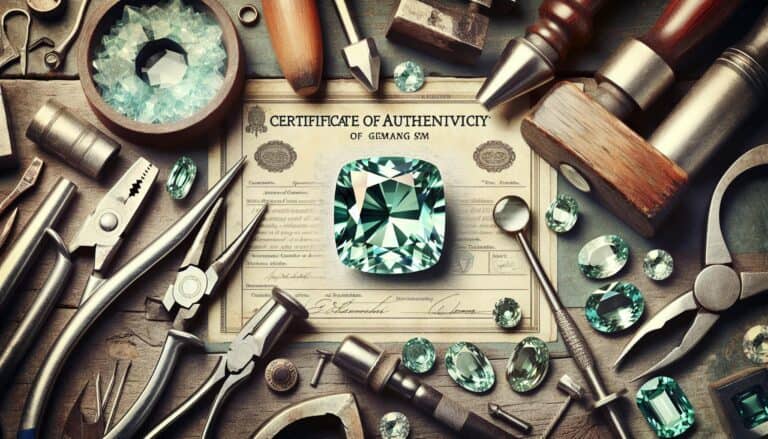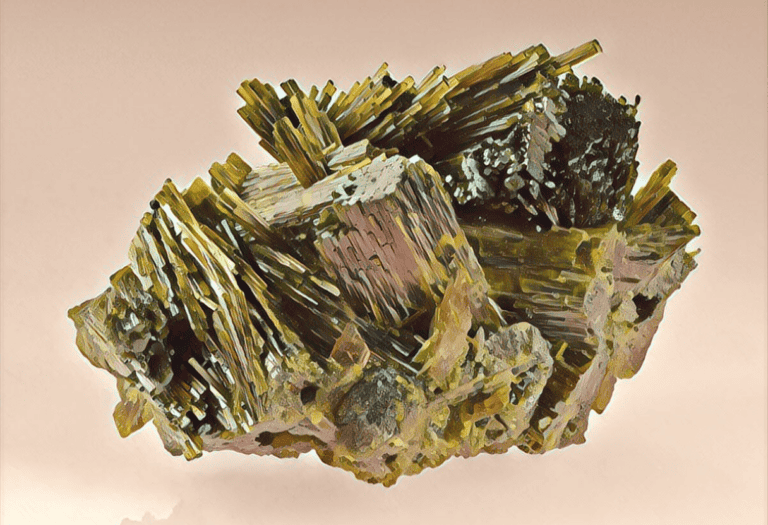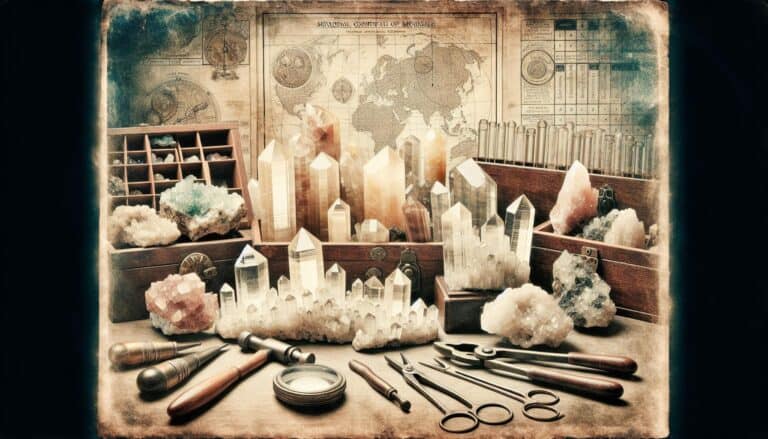Imagine stumbling across a piece of wood that’s as old as the dinosaurs.
Petrified wood isn’t your everyday find; it’s a fossil, a piece of ancient life frozen in time. Identifying petrified wood can be a thrilling experience, but you’ll need to know what to look for.
The transformation from wood to stone is a journey millions of years in the making. With the right knowledge, you’ll be able to spot the telltale signs of this natural marvel. Whether you’re hiking in the great outdoors or sifting through a rock shop, knowing how to identify petrified wood adds an exciting layer to your adventures.
Texture, weight, and color are your clues in this fascinating treasure hunt.
Let’s dive into the world of petrified wood and uncover the secrets to recognizing this ancient treasure.
To identify petrified wood, inspect for wood grain patterns and ring structures, which often preserve during petrification. Petrified wood typically leaves a white streak and may show magnetic properties due to iron oxide content. It has a hardness of 6.5-7 on the Mohs scale and often exhibits a glassy luster.
How to Identify Petrified Wood Through Testing
When you’re out exploring, it’s thrilling to discover a piece of history such as petrified wood. To confirm your findings, several tests can be performed that rely on physical and optical properties.
Visual Inspection
Begin with a Visual Inspection. Look for wood grain patterns and the presence of ring structures, as these features often preserve well during the petrification process. Petrified wood may also have a glassy luster that differentiates it from ordinary rocks.
The Streak Test
To perform the streak test, rub the sample on an unglazed porcelain tile known as a streak plate. Petrified wood typically leaves a white streak, which can help differentiate it from other minerals.
Magnet Test
The magnet test involves running a strong magnet over the surface of your sample. Some petrified woods contain iron oxide, which can make them magnetically attractive.
Hardness Test
Petrified wood falls between 6.5 and 7 on the Mohs hardness scale. Use a hardness kit to see how easily the sample can be scratched compared to known materials of specific hardness levels.
Birefringence Test
Birefringence is an optical property where a material splits a ray of light into two paths. Using a polarizing microscope, check if your sample displays double refraction, which indicates the presence of crystallized minerals like quartz in petrified wood.
Checking The Diaphaneity
Diaphaneity means how much light passes through a material. Petrified wood can range from translucent to opaque. Hold the specimen up to a light source and note how much light, if any, filters through.
Single or Double Refraction
Observe whether the sample refracts light once (single refraction) or twice (double refraction). This can be checked using a refractometer. As many petrified woods are made of quartz, they commonly exhibit single refraction.
Refractive Index Test
The refractive index test measures how much light bends as it passes through the sample. Petrified wood will often have a refractive index similar to quartz (around 1.54 – 1.55).
Finding The Specific Gravity
Measure the specific gravity, which is the ratio of the density of a substance to the density of water. Petrified wood has a specific gravity of about 2.4 to 2.8, wich is denser than most common rocks.
Identifying Petrified Woods in the Field
Identifying petrified wood in the field involves examining the environment where you found the sample. Look for other signs of fossilized matter or terrain where ancient forests might have stood.
Recognizing Potential Petrified Wood Rocks
Keep an eye out for rocks with a bark-like surface or ones that seem out of place amongst their surroundings. Often, what might appear to be a rock at first glance could be a potential piece of petrified wood worth investigating further.
Physical Characteristics of Petrified Wood

When you’re on the hunt for petrified wood, knowing its physical characteristics is crucial. Petrified wood is renowned for its distinct textures and colors, which can vary widely but often include shades of brown, red, yellow, or even green due to the minerals that have replaced the organic material.
Texture and Weight
On a tactile level, you’ll notice that petrified wood has a smoothness reminiscent of glass or polished stone; this is due to the silicification process. Despite this smoothness, petrified wood can be significantly heavier than ordinary rocks of the same size because its porous organic material has been replaced with minerals, chiefly silica.
Rings and Structure
Often, the original structure of the wood is preserved. Here’s what to look for:
- Growth rings that delineate seasons of growth, typically visible as concentric circles
- The fibrous structure of wood, although now in solid stone form
- Knots and branches often remain discernible, reflecting the wood’s living history
Identifying petrified wood also involves recognizing these structural landmarks that hint at its woody origins. By examining smooth cross-sections that reveal rings or longitudinal cuts that showcase fibrous patterns, you can often confirm that you’re indeed looking at petrified wood. What once were soft fibers and living tissues have transformed into a record of geological time, waiting to be uncovered by observant eyes like yours.
How Are Petrified Wood Formed?
Unearthing the origins of petrified wood is key to understanding its identity. Over millions of years, wood becomes petrified through a process called permineralization. This intriguing transformation occurs when wood is quickly buried under sediment, creating an environment free of oxygen which is necessary to preserve the wood’s structure.
As time progresses, groundwater rich in dissolved solids flows through the sediment, depositing minerals in the wood’s cells. As the organic material decays, these minerals crystallize, replacing the cellular structure of the wood. It’s this unique process that fossilizes the wood, turning it into a stony replica.
The most common mineral to petrify wood is silica, but traces of iron, carbon, and manganese can also be found. These elements add vibrant hues to the petrified wood. Quartz is the predominant form of silica found in petrified wood and contributes to the durability and glass-like lustre that this fossilized material often exhibits.
Petrification details matter when identifying petrified wood. The mineral content and the conditions under which the wood petrified play significant roles in dictating the visual characteristics of the final specimen. Understanding the process helps in pinpointing the type and age of the petrified wood you’re examining.
Preparation for Petrified Wood Hunting
Before heading out on your adventure, it’s critical that you’re well-prepared. This preparation will not only make your hunting more efficient but also ensure your safety. Below are essential tips to equip you for your journey into the world of ancient fossilized forests.
Gathering the Right Tools
To maximize the potential of your petrified wood hunting excursion, you’ll need an assortment of tools. This equipment will aid in both the identification and the retrieval of specimens.
- Geologist’s hammer or rock pick: This is essential for chipping samples and extracting pieces embedded in matrix.
- Hand lens or magnifier: For close-up examination of texture and grain.
- GPS device or map and compass: Vital for navigating remote locations and marking finds.
- Durable gloves: To protect your hands during digging and handling sharp rocks.
- Sturdy footwear: Preferably hiking boots for traversing rough terrain.
Remember, the right tools are not only about success but also about preserving the integrity of your finds. Fragile specimens require a light touch and appropriate transportation, like bubble wrap or foam-lined boxes, to prevent damage.
Safety Considerations
Your safety is paramount in any outdoor activity. Petrified wood hunting can lead you to remote and sometimes treacherous locations. Here are key points to remember:
- Inform someone of your travel plans and expected return.
- Pack a first-aid kit for emergency medical treatments.
- Wear bright clothing to be visible to others, especially in areas with hunting activity.
- Carry sufficient water and food; dehydration and fatigue are serious risks.
- Be mindful of the weather and dress accordingly; hypothermia and heatstroke are threats in extreme conditions.
- Watch out for wildlife and know the proper response if you encounter dangerous animals.
By taking these precautions, you’ll be able to focus on the thrill of discovery rather than dealing with preventable misfortunes. Your preparedness can be the difference between a fruitful hunt and a regrettable mishap. With your tools ready and safety measures in place, you’re one step closer to uncovering the geological treasures that await.
Handling and Care of Found Petrified Wood

Once you’ve located and collected petrified wood, it’s crucial to handle and care for these geological treasures properly. Petrified wood is a fascinating material, transformed from wood to stone over millions of years, yet it still requires careful treatment to maintain its beauty and scientific value.
Cleaning Petrified Woods
Your first step in caring for petrified wood is cleaning it without causing damage. Begin by gently brushing off any loose dirt with a soft brush. If you’ve discovered petrified wood with more significant sediment or debris, you can wash it with water and a mild soap. Be cautious, as some specimens have fragile sections that can deteriorate if handled too roughly.
For tougher residues, you might consider using a rock tumbler. However, tumbling should only be done on specimens that you’re sure can withstand the process, as it can wear down the wood’s unique characteristics and detail.
Here are some dos and don’ts for cleaning petrified wood:
- Do use soft tools like a brush or cloth.
- Do rinse with water to remove soap thoroughly.
- Don’t use harsh chemicals or abrasives.
- Don’t soak petrified wood as it can cause it to weaken or break.
Storing Petrified Wood
Once your petrified wood is clean, storing it correctly ensures its long-term preservation. Always store petrified wood in a cool, dry place out of direct sunlight, as UV rays can fade the colors over time. If you’ve multiple pieces or a sizeable collection, you might need to consider cushioning them individually to prevent chipping or breakage.
A display case that secures the wood while showcasing it is an ideal way to store these pieces. If you’re not displaying your petrified wood, wrap each piece in a soft cloth or place it inside a padded box. This will protect the specimen from scratches or other mechanical damage.
When arranging petrified wood for storage or display, consider these points:
- Ensure the surface is steady and does not transfer moisture.
- Separate different pieces to avoid contact, which could lead to scratches or cracks.
- Monitor the environment for changes in temperature and humidity that can stress the petrified wood.
Conclusion: Confirming Petrified Wood is Real
Identifying petrified wood is a fascinating process that connects you with the ancient world.
Remember that the true value of your find lies not only in its visual appeal but also in its historical significance. By following the guidance on cleaning and caring for petrified wood you’ve ensured your piece remains a timeless treasure. Whether displayed in your home or added to a collection your petrified wood is a testament to nature’s artistry and the eons that have shaped it. Now that you’re equipped with the knowledge to identify and preserve these natural wonders go forth and explore with confidence.
Your next discovery awaits!




![Setting Prices for Handmade Jewelry [year]](https://observationhobbies.com/wp-content/uploads/2024/01/dVTRvDJ0W4koSsyHjCF9V-768x439.jpg)


